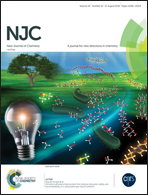Effect on Schottky behaviour of 1D coordination polymers by altering para-substituents on benzoate ligands†
Abstract
Two Zn(II) based one-dimensional coordination polymers (1D CPs) [Zn6(bpd)3(p-clba)6(μ3-OH)4]·(p-clba)2·(CH3OH), (1) and [Zn6(bpd)3(p-brba)6(μ3-OH)4]·(p-brba)2·(CH3OH), (2) (bpd = 1,4-bis(4-pyridyl)-2,3-diaza-1,3-butadiene, H2p-clba = para-chlorobenzoic acid and H2p-brba = para-bromobenzoic acid) were synthesised by slow diffusion and structurally characterised by single crystal X-ray crystallography. Compound 1 and 2 were isotypical, containing a chair-like hexagonal [Zn6(μ3-OH)4]8+ secondary building unit. Hydrogen bonding, π⋯π and interchain C–H⋯X (X = Cl and Br) interactions had major contributions for the formation of supramolecular architecture in the crystal lattice. Interestingly, these two compounds exhibited high electrical conductivity and revealed Schottky barrier diode behaviour. However, the space charge limited current conductivity and mobility of compound 1 was enhanced as compared with 2 by 58% and 10%, respectively, owing to the modification of para-substituents on benzoate ligands.



 Please wait while we load your content...
Please wait while we load your content...